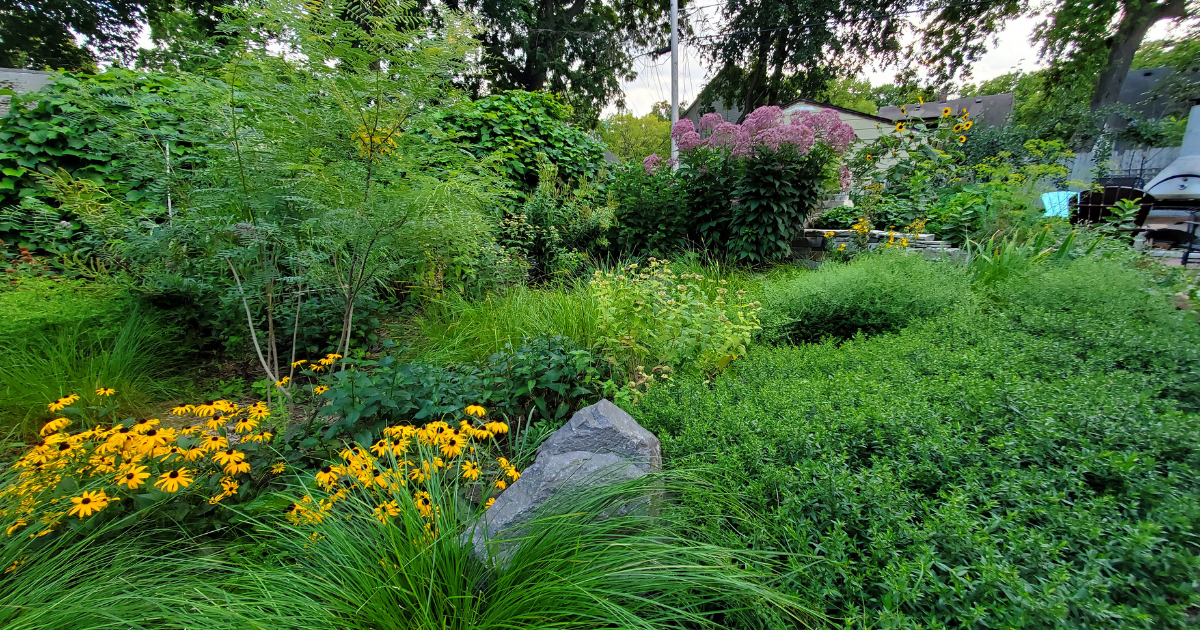How to Build a Rain Garden
Rain gardens collect and filter storm-water runoff from impermeable surfaces such as building rooftops and parking lots. These surfaces often contain pollutants and debris like chemicals from cars, pet waste, grass clippings, road salt, and other nutrient-heavy sediment that rainfall washes away. We can prevent these foreign particles from washing into nearby waterways by redirecting rainfall into rain gardens – shallow depressed gardens planted specifically with plants that filter the pollutants and absorb stray nutrients.
Aside from mitigating pollutants, rain gardens are also a smart way to collect and use water that would otherwise run directly into our storm-water sewers. Rain gardens attract wildlife, create beauty, and require minimal maintenance once established. Interested? Here’s how you can design and install your own rain garden.
Location
Rain gardens are most effective when they’re near whatever water source will be filling them. You might already have a low spot in your yard that holds standing water after significant rainfalls — this would be an easy place to install a rain garden. Otherwise, most residential rain gardens are located close to their homes’ downspouts, driveways, or sidewalks, where rainfall quickly accumulates. If your rain garden will be receiving water directly from your downspouts, consider installing catch basins with buried plastic piping that drains into the garden’s center.
Your rain garden should be at least 10 feet away from buildings to eliminate potential issues with water getting into basements. Rain gardens should also be at least 35 feet away from septic system drain fields and 50 feet from drinking water wells. You’ll want to observe a few heavy rainfalls to learn which way the water flows off the surfaces around your home before making any final placement decisions.
Preparation
The soil in a rain garden is really important: you want the garden to drain within 48 hours of filling with rainwater. Otherwise, you risk drowning your plants and providing breeding habitat for mosquitoes. To find out if the soil in your potential rain garden locale will drain properly, dig a hole that’s at least 10 inches deep and wide. Fill it with water. If the water drains completely over the next 48 hours, the soil is appropriate for rain garden construction. No additional soil amendment is needed unless a soil test reveals a specific nutrient deficiency.
Next, you’ll want to consider the overall size of the garden, which will depend on the size of the roof or hard surfaces draining into it. Rain gardens can generally process the runoff water from a surface about three times their size, which means typical home rain gardens are around 100 to 300 square feet.
After you define the garden’s boundaries, it’s time to dig! The deepest part of the rain garden should be about six inches below the grade of the surrounding ground. The bottom of the rain garden should be a flat, level surface, like the bottom of a swimming pool. You can then grade the rest of the garden into a gentle slope between the low point and the edges. Remove any excess soil from the site altogether.
Planting
Choose the plants in your rain garden (and their location within the planting) based on how much water they need overall and how much standing water they can tolerate. It’s helpful to break the garden into three zones or rings that each extend around the garden’s circumference. The bottom zone needs plants that are tolerant of standing water, as the garden might be full of rainwater for up to two days. The plants in the middle zone will receive some heavy moisture but then dry out completely as the garden drains. The outer ring of plants will only get limited water from rainfall, so these plants should be very drought tolerant.
Check out the University of Minnesota Extension and Blue Thumb for rain garden plant lists, inspiration and additional tips and tricks.
Horticulturist Laura Schwarz lives in Minneapolis, where she works in garden design, installation and maintenance.
To learn more, join a webinar or workshop… UPCOMING CLASSES

